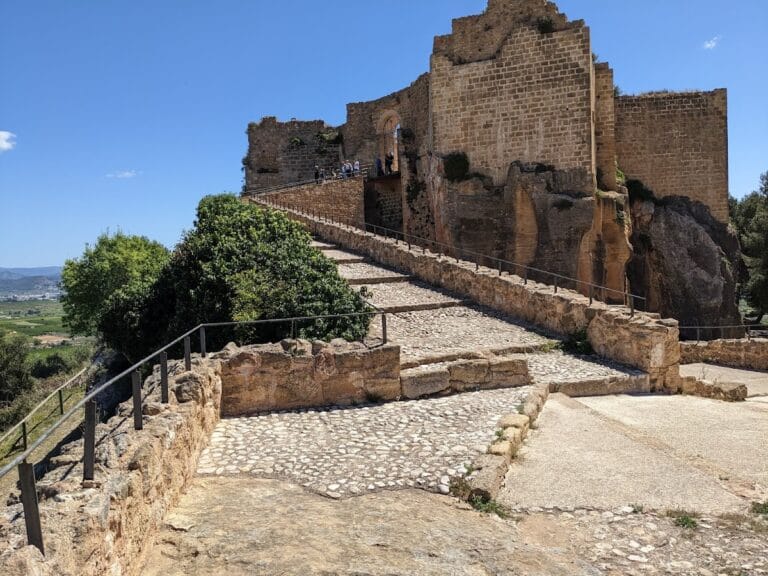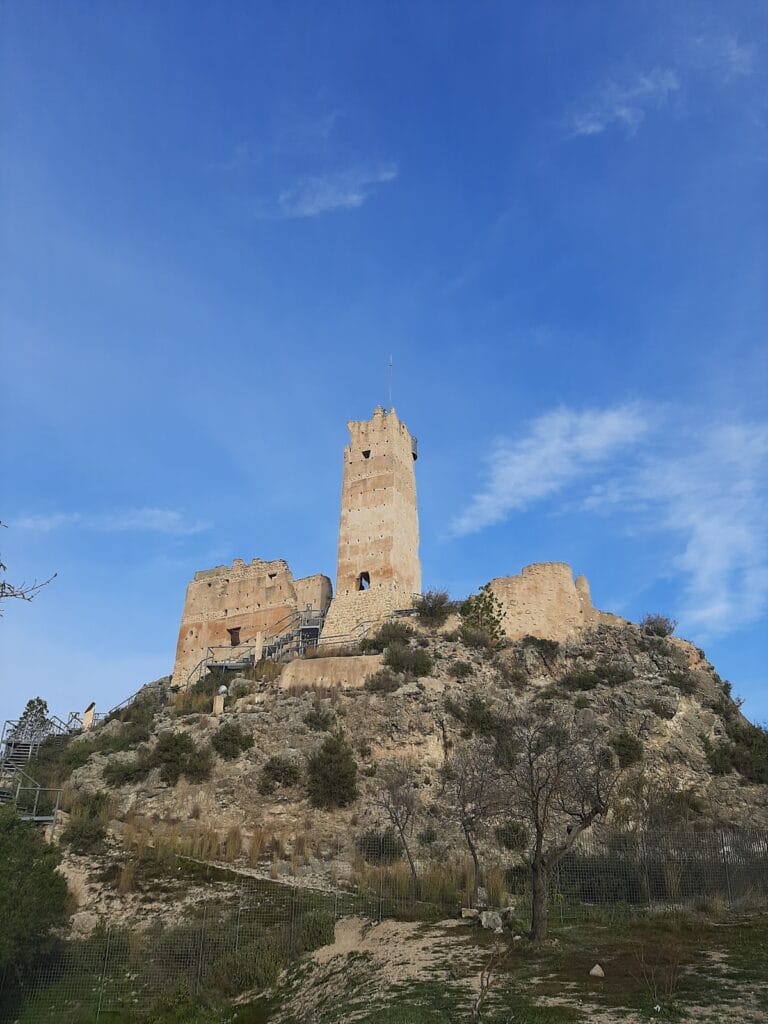Castle of Xàtiva: A Historic Fortress in Spain
Visitor Information
Google Rating: 4.5
Popularity: High
Google Maps: View on Google Maps
Official Website: xativaturismo.com
Country: Spain
Civilization: Unclassified
Remains: Military
History
The Castle of Xàtiva is situated above the city of Xàtiva in Spain and was originally established by the Iberians. Its position atop the Serra del Castell provided a commanding view and control over access from the Kingdom of Castile into the Kingdom of Valencia, making it a strategic fortress throughout history.
Initially, the site began as an Iberian fortification on the mountain’s highest point, known as Castell Menor. During Roman times, a second fortress, called Castell Major, was added at another elevated spot on the same mountain. The Romans connected these two strongholds, creating a broader defensive complex. Subsequently, the Arabs expanded and reformed the fortifications, enlarging the city walls to nearly their current extent, reflecting the castle’s importance during the Muslim period.
Following the Christian reconquest and the establishment of the Kingdom of Valencia, the castle and its city remained crucial military and administrative centers. Between the 13th and 16th centuries, the castle served as a state prison for the Crown of Aragon, detaining notable figures such as the Infantes de la Cerda and the Count of Urgell. This role underscores its significance within the political structure of the region during this period.
The castle’s military importance continued into the early 18th century but began to wane due to advances in warfare technology. During the War of the Spanish Succession, its medieval walls were weakened by heavy artillery fire. General Joan Baptista Basset undertook reinforcement efforts, including the construction of the Garita Basset tower, yet after a prolonged siege in 1707, the fortress was compelled to surrender.
In the following decades, the castle saw further use during the Peninsular War but suffered considerable damage both from a major earthquake in 1748 and ongoing military conflicts. These events contributed to its gradual decline and reduced strategic relevance.
In the 20th century, the castle underwent a notable revival when industrialist Gregori Molina acquired the site and added a neo-Gothic complex that complemented the older structures. This addition effectively created what locals refer to as the “third castle.” Ownership later shifted to financial institutions and eventually to the Generalitat Valenciana, with management currently in the hands of the Xàtiva City Council, preserving the castle’s legacy as a cultural heritage site.
Throughout its history, the castle has inspired legends linked to ancient figures. The Gothic Porta d’Hanníbal, a gate dating to the 15th century, recalls the legendary passage of Hannibal Barca and Scipio during the Second Punic War. Nearby, the Torre de la Reina is associated with Queen Himilce, an Iberian woman said to have borne Hannibal’s son around 218 BC, blending historical memory with regional myth.
Remains
The Castle of Xàtiva is composed of two primary sections perched on the mountain ridges: Castell Major on the right and Castell Menor on the left. These fortifications are connected by a central courtyard, the plaza d’armes, which integrates both medieval and modern elements. The castle’s walls utilize a combination of Roman construction techniques and later medieval modifications, creating a layered historical fabric.
Access to the site begins via a steep path leading to the Porta Ferrisa, or Iron Gate, a modern reconstruction displaying the city’s coat of arms flanked by royal emblems. This entrance leads into the central courtyard, which houses 20th-century neo-Gothic buildings and a tower, blending historical styles with new construction designed for exhibitions and social functions.
Within Castell Major, visitors find the neo-Gothic Chapel of Saint George, believed to stand on the site of the medieval Chapel of Santa Anna, marking a continuity of religious use. Ascending through this area brings one to a gardened terrace with a staircase flanked by three historic cannons. These artillery pieces, first documented in 1580, were recast in 1690 and played an active role during the War of the Spanish Succession, still noted in catalogs as late as 1742.
The Torre Redona, or Round Tower, figures prominently in the castle’s history, with maintenance records from 1411 and 1580 testifying to its longstanding defensive role. Near this tower lie the remains of the second gate, identifiable by the Roman opus spicatum (a herringbone-patterned paving) beneath its flooring. This gate was constructed with a bent passage for enhanced defense and was safeguarded by flanking towers.
Adjacent to this area are structures from the Arab period, such as a Muslim-era oven utilized by castle guards and a cistern of Arabic origin, known as an aljub, which collected and stored water. Outside the defensive walls, four Roman cisterns covered with Gothic vaults provide further evidence of the site’s layered use and water management systems.
The third gate, called the Portal de Santa Maria, was rebuilt in 1415, with its pavement dating from 1439. Beyond it stands the Gothic Chapel of Santa Maria, a well-preserved building initially constructed in 1276 and extensively rebuilt between 1431 and 1434 under Queen Maria, spouse of Alfonso the Magnanimous. This chapel features a single nave with three ribbed vaults supported by corbels bearing royal insignia. Within lies a modern sarcophagus reputed to contain the remains of the Count of Urgell, linking the site to notable medieval nobility.
Opposite the chapel sits the base of the Torre de Sant Jordi, originally of Roman foundation but repaired in 1433. Once among the tallest towers in the complex, it sustained damage during the 1748 earthquake and later during the Peninsular War, leaving only partial remains today.
At the summit of Castell Major lies the seloquia, considered the highest Muslim castle zone. This area includes two courtyards surrounded by rooms such as Moorish chambers and quarters once occupied by the Duke of Calabria. Remnants of opus spicatum paving and two Gothic arches from the 15th century survive here, marking the spaces used by governors and guards.
One of the castle’s most historically significant spaces is the Presó Fosca, or Dark Prison, which housed many prominent prisoners over several centuries. A plaque at its entrance honors these detainees from the 13th through the 16th centuries. Above this prison is the Sala Nova of the Duke of Calabria, featuring a Renaissance window dated between 1512 and 1522. Nearby, the highest cistern of the castle and a stairway provide access to this hall and to the tower that once held the castle bell, employed during the 17th century to signal alarms, guard changes, and irrigation times.
The Torre de la Fe, once paired with Torre de Sant Jordi as the tallest tower, survives now only as foundations. It was severely damaged after an explosion in 1563, reconstructed six years later, and ultimately destroyed by the earthquake of 1748 and further warfare damage in 1813.
Outside the main fortifications lies the Garita Basset, an albarrana tower named after General Joan Baptista Basset who repaired it in 1705. Albarrana towers are detached defensive towers linked to the main walls, used as lookout and defensive posts.
On the opposite side, Castell Menor, although smaller, is the older part of the fortress. Entry comes through the Porta d’Hanníbal, a Gothic gate from the 15th century named in memory of the legendary crossing of Hannibal Barca and Scipio during the Second Punic War. This section includes a square tower with original Roman foundations.
Ascending the inner enclosure of Castell Menor involves passing through a bent Gothic gate with a tower restored in the 15th century. Inside stands the Torre de la Reina, which now features a modern balcony called the Balcony of Queen Himilce, associated with the Iberian woman who, according to tradition, bore Hannibal’s son in 218 BC.
Within Castell Menor remain practical spaces like the cistern, old stables, animal pens near the north wall, and latrines. At its highest point is the Torre de l’Esperó, known since the 14th century for its defensive spur formation relative to the castle walls. Like Castell Major, this part of the fortress also includes albarrana towers outside its defenses, serving as watchpoints and strongholds.
Together, these features document a complex site continuously adapted through Iberian, Roman, Muslim, and Christian periods, reflecting the Castle of Xàtiva’s long military, political, and social history.










